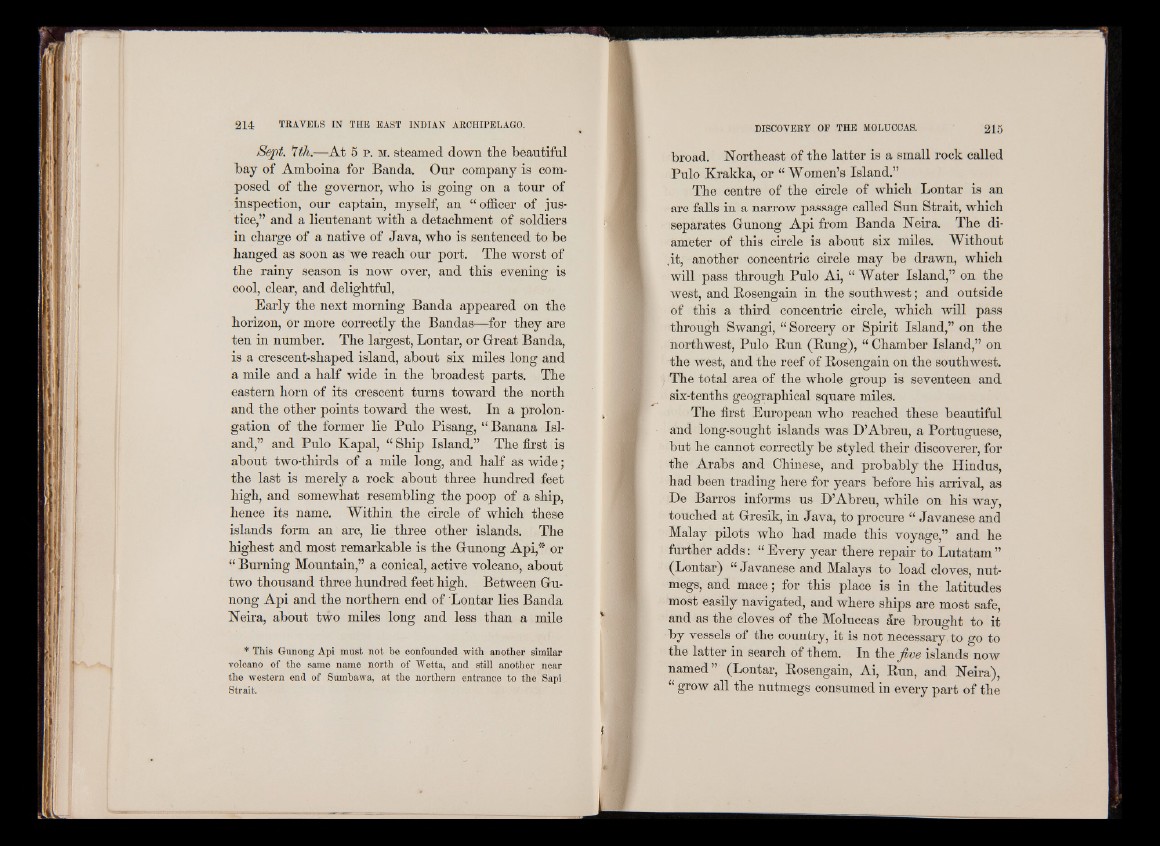
Sept. —At 5 p. m. steamed down the beautiful
bay of Amboina for Banda. Our company is composed
of the governor, who is going on a tour of
inspection, our captain, myself, an “ officer of justice,”
and a lieutenant with a detachment of soldiers
in charge of a native of Java, who is sentenced to be
hanged as soon as we reach our port. The worst of
the rainy season is now over, and this evening is
cool, clear, and delightful,
Early the next morning Banda appeared on the
horizon, or more correctly the Bandas—for they are
ten in number. The largest, Lontar, or Great Banda,
is a crescent-shaped island, about six miles long and
a mile and a half wide in the broadest parts. The
eastern horn of its crescent turns toward the north
and the other points toward the west. In a prolongation
of the former lie Pulo Pisang, “ Banana Island,”
and Pulo Kapal, “ Ship Island.” The first is
about two-thirds of a mile long, and half as wide;
the last is merely a rock about three hundred feet
high, and somewhat resembling the poop of a ship,
hence its name. Within the circle of which these
islands form an arc, lie three other islands. The
highest and most remarkable is the Gunong Api,* or
“ Burning Mouutain,” a conical, active volcano, about
two thousand three hundred feet high. Between Gunong
Api and the northern end of Lontar lies Banda
Neira, about two miles long and less than a mile
* This Gunong Api must not be confounded with another similar
volcano of the same name north of "Wetta, and still another near
the western end of Sumbawa, at the northern entrance to the Sapi
Strait.
broad. Northeast of the latter is a small rock called
Pulo Krakka, or “Women’s Island.”
The centre of the circle of which Lontar is an
arc falls in a narrow passage called Sun Strait, which
separates Gunong Api from Banda Neira. The diameter
of this circle is about six miles. Without
,it, another concentric circle may be drawn, which
will pass through Pulo Ai, “ Water Island,” on the
west, and Rosengain in the southwest; and outside
of this a third concentric circle, which will pass
through Swangi, “ Sorcery or Spirit Island,” on the
northwest, Pulo Run (Rung), “ Chamber Island,” on
the west, and the reef of Rosengain on the southwest.
The total area of the whole group is seventeen and
six-tenths geographical square miles.
The first European who reached these beautiful
and long-sought islands was D’Abreu, a Portuguese,
but he cannot correctly be styled their discoverer, for
the Arabs and Chinese, and probably the Hindus,
had been trading here for years before his arrival, as
De Barros informs us D’Abreu, while on his way,
touched at Gresik, in Java, to procure “ Javanese and
Malay pilots who had made this voyage,” and he
farther adds: “ Every year there repair to Lutatam ”
(Lontar) “ Javanese and Malays to load cloves, nutmegs,
and mace; for this place is in the latitudes
most easily navigated, and where ships are most safe,
and as the cloves of the Moluccas áre brought to it
by vessels of the country, it is not necessary, to go to
the latter in search of them. In the jwe islands now
named” (Lontar, Rosengain, Ai, Run, and Neira),
“ grow all the nutmegs consumed in every part of the